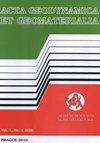Application of microgravity and electrical resistivity imaging techniques to identify ground subsidence prone zone
IF 0.9
4区 地球科学
Q4 GEOCHEMISTRY & GEOPHYSICS
引用次数: 1
Abstract
Owing to the disastrous consequences of ground subsidence in the urban area, great attention had always been accorded to areas with suspected signs of subsidence occurrence in order to mitigate its effect. Microgravity and electrical resistivity imaging (ERI) survey techniques were conducted at a parking lot of which possible occurrence of subsidence is anticipated due to the increased exposure of surface cracks and very slight depression. This study aimed to map and delineate the subsurface condition of the area with the view of revealing probable subsidence prone zones within the study area. To this end, the microgravity survey data was acquired at a station interval of 2 m. Pole-dipole configuration with 2 m electrode separation was adopted for the electrical resistivity imaging survey. The two methods showed good correlation with each other and proved their effectiveness in imaging the subsurface. A large proportion of the subsurface area was found to be residual soil (mainly silt and or clayey sand) with saturated zones identified by low gravity (< - 40.94 mGal) and resistivity (<150 Ω.m) values, which have the tendency to undergo expansion and contraction processes due to rise and fall in moisture content. The subsurface condition was found to be relatively stable, devoid of any subsidence triggering features such as voids or cavities. However, it is inferred to be unsuitable for engineering structures due to the expansive and contractive properties of the subsurface geomaterials (residual soil). Therefore, it is concluded that the area is not prone to subsidence and the surface cracks presents are mere effects of the expansion and contraction process, which could be avoided by the excavation of the expansive soil or good engineering design before the establishment of any structure.应用微重力和电阻率成像技术识别地面沉降易发区
由于城市地区地面沉降的灾难性后果,一直高度重视疑似有沉降迹象的地区,以减轻其影响。微重力和电阻率成像(ERI)测量技术在一个停车场进行,由于地表裂缝的暴露增加和非常轻微的凹陷,预计可能会发生下沉。本研究旨在绘制和描绘该地区的地下状况,以期揭示研究区内可能的下沉易发区。为此,以2 m的站距获取微重力测量数据。电阻率成像测量采用电极间距为2 m的极-偶极结构。两种方法具有良好的相关性,证明了两种方法在地下成像中的有效性。大部分地下面积为残余土(主要为粉砂和/或粘砂),具有低重力(< - 40.94 mGal)和电阻率(<150 Ω.m)确定的饱和带,这些饱和带由于含水率的上升和下降而发生膨胀和收缩的趋势。发现地下条件相对稳定,没有任何引发沉降的特征,如空洞或空腔。然而,由于地下岩土材料(残积土)的膨胀和收缩特性,推断其不适合用于工程结构。因此,该区域不容易发生沉陷,地表裂缝的出现仅仅是膨胀和收缩过程的影响,在建立任何结构之前,通过开挖膨胀土或进行良好的工程设计是可以避免的。
本文章由计算机程序翻译,如有差异,请以英文原文为准。
求助全文
约1分钟内获得全文
求助全文
来源期刊

Acta Geodynamica et Geomaterialia
地学-地球化学与地球物理
CiteScore
2.30
自引率
0.00%
发文量
12
期刊介绍:
Acta geodynamica et geomaterialia (AGG) has been published by the Institute of Rock Structures and Mechanics, Czech Academy of Sciences since 2004, formerly known as Acta Montana published from the beginning of sixties till 2003. Approximately 40 articles per year in four issues are published, covering observations related to central Europe and new theoretical developments and interpretations in these disciplines. It is possible to publish occasionally research articles from other regions of the world, only if they present substantial advance in methodological or theoretical development with worldwide impact. The Board of Editors is international in representation.
 求助内容:
求助内容: 应助结果提醒方式:
应助结果提醒方式:


